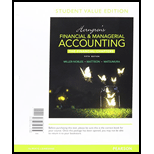
Concept explainers
1)
Profitability ratios: In general, financial ratios are used to evaluate capabilities, profitability, and overall performance of a company. The following are the ratios that evaluate the profitability of a company:
- Profit margin ratio: Profit margin ratio is used to determine the percentage of net income that is being generated per dollar of revenue or sales.
Formula:
Rate of return on total assets: Return on assets determines the particular company’s overall earning power.
Formula:
- Asset turnover ratio: Asset turnover ratio is used to determine the asset’s efficiency towards sales.
Formula:
- Rate of return on common
stockholders’ equity : Rate of return on stockholders’ equity is used to determine the relationship between the net income and the average common equity that are invested in the company.
Formula:
To compute: Profitability ratios
Given info: Income statement and Balance sheet
2)
To Compute: the rate of return on total assets for Company S for 2016.
3)
To Compute: the asset turnover for the Company S for the year 2016.
4)
To Compute: the rate of return on common stockholders’ equity for the Company S for the year 2016.
5)
To comment: Whether the company is strong or weak.
Want to see the full answer?
Check out a sample textbook solution
Chapter 15 Solutions
Horngren's Financial & Managerial Accounting, The Financial Chapters (Book & Access Card)
- Can you provide the accurate answer to this financial accounting question using correct methods?arrow_forwardCan you explain the correct approach to solve this general accounting question?arrow_forwardPlease provide the answer to this general accounting question using the right approach.arrow_forward
- I am searching for the accurate solution to this general accounting problem with the right approach.arrow_forwardD&G ENTERPRISES ISSUES BOND WITH A $1,000 FACE VALUE THAT MAKES COUPON PAYMENTS OF $10 EVERY 3 MONTHS. WHAT IS THE COUPON RATE? A. 1% B. 4% C. 6% D. 8% E. 12%arrow_forwardCan you help me solve this general accounting question using the correct accounting procedures?arrow_forward
- I am looking for a reliable way to solve this financial accounting problem using accurate principles.arrow_forwardCan you explain the correct approach to solve this general accounting question?arrow_forwardCan you demonstrate the proper approach for solving this financial accounting question with valid techniques?arrow_forward
- Can you solve this general accounting problem using accurate calculation methods?arrow_forwardA company had an income of $60,000 using absorption costing for a given period. Beginning and ending inventories for that period were 13,000 units and 18,000 units, respectively. Ignoring income taxes, if the fixed overhead application rate was $3.00 per unit, what was the income using variable costing? A. $75,000. B. $60,000. C. $45,000. D. Not sufficient information to determine.arrow_forwardCan you solve this general accounting problem with appropriate steps and explanations?arrow_forward
 Financial AccountingAccountingISBN:9781305088436Author:Carl Warren, Jim Reeve, Jonathan DuchacPublisher:Cengage Learning
Financial AccountingAccountingISBN:9781305088436Author:Carl Warren, Jim Reeve, Jonathan DuchacPublisher:Cengage Learning EBK CONTEMPORARY FINANCIAL MANAGEMENTFinanceISBN:9781337514835Author:MOYERPublisher:CENGAGE LEARNING - CONSIGNMENT
EBK CONTEMPORARY FINANCIAL MANAGEMENTFinanceISBN:9781337514835Author:MOYERPublisher:CENGAGE LEARNING - CONSIGNMENT


